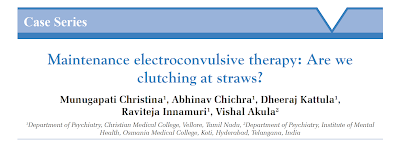Maintenance ECT: Case Series From India
Out on PubMed, from clinicians in India, is this article:
Maintenance electroconvulsive therapy: Are we clutching at straws?
J Family Med Prim Care. 2022 Jul;11(7):4088-4093. doi: 10.4103/jfmpc.jfmpc_2389_21. Epub 2022 Jul 22.PMID: 36387666
The abstract is copied below:
Introduction: The available treatment options for patients with drug or treatment-resistant psychiatric disorders are limited. Maintenance electroconvulsive therapy (M-ECT) is an established option, but the literature available is limited. This study examined the utilization of M-ECT in a large tertiary care psychiatric facility, and its correlates with the socio-demographic and clinical profile of patients.
Methods: A retrospective chart review was performed in a tertiary care psychiatry center based in semi-urban South India, and data was analyzed.
Results: A total of 171 patients received ECT in the study period, of which only five patients were on M-ECT. These patients were diagnosed as treatment-resistant and were mostly suffering from schizophrenia. They were located less than 30 km from the hospital. They were on regular treatment but continued to have residual symptoms without functional recovery and required a high level of support from caregivers.
Conclusion: Our study supports the effectiveness of M-ECT for the treatment of severe psychiatric disorders and highlights the profile of patients who have received this modality of treatment. It can be suggested with consideration of various psycho-social issues which seem to be related to adherence.
Keywords: Drug resistance; M-ECT; long-term ECT; maintenance electroconvulsive therapy; treatment resistance.
The article is here.
And from the text:
Here are 5 case reports (4 patients with schizophrenia, 1 with schizoaffective disorder) demonstrating good-excellent outcomes with maintenance ECT (MECT). The title of the report seems quite ridiculous, given the positive nature of the reported results. I suppose it was chosen as an attention-getter. While case reports are always interesting, these add little to the existing literature. Their value is to introduce ECT and MECT to an audience of family and primary care physicians. For that, we give the authors kudos for their overall effort, but not for the title.




Comments
Post a Comment